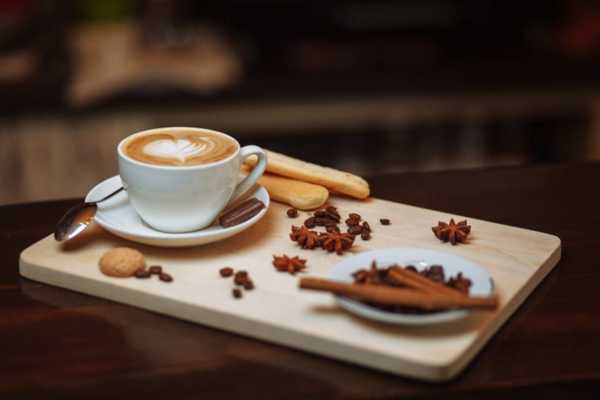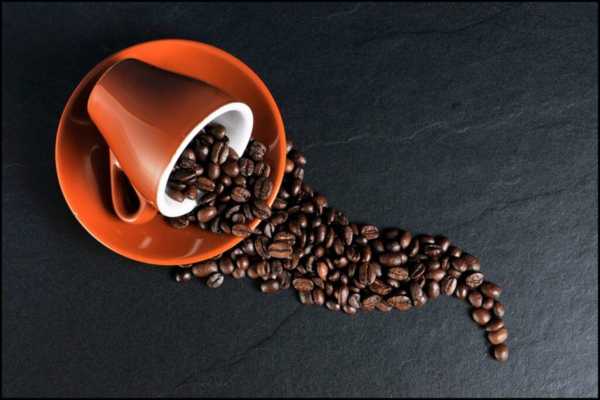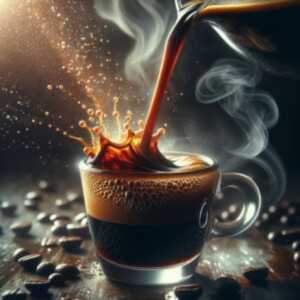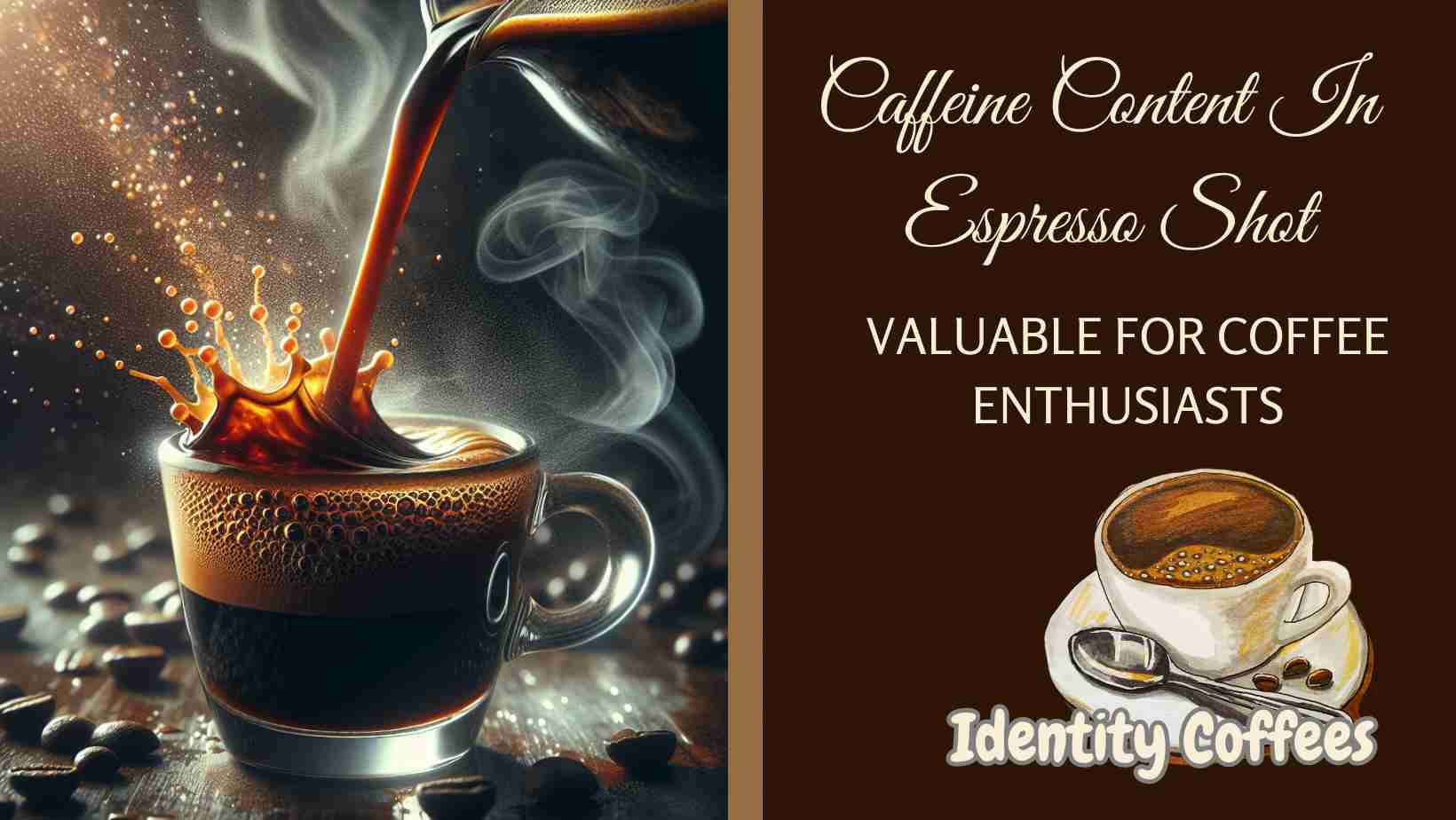Curious about the caffeine content in an espresso shot? Look no further! In this article, we’ll explore the amount of caffeine you can expect to find in a single espresso shot, as well as the caffeine in double espresso. Whether you’re an avid coffee lover or simply looking for a little pick-me-up, understanding the caffeine content in your espresso can help you make informed choices about your daily dose of energy. So, grab your favorite mug and let’s dive into the world of espresso caffeine!
Overview of Caffeine in an Espresso Shot
Understanding the Basics of Espresso
Espresso is a concentrated form of coffee that is brewed by forcing hot water through finely ground coffee beans. This brewing method results in a small, intense shot of coffee that is highly regarded for its rich flavor and strong caffeine content. In a traditional espresso shot, about 1-1.5 ounces of water is forced through 18-20 grams of coffee grounds.
What is Caffeine?
Caffeine is a natural stimulant that is found in coffee beans, tea leaves, and various other plants. It is a central nervous system stimulant and acts as a mild psychoactive substance, often providing individuals with increased alertness and focus. Caffeine is renowned for its ability to provide a temporary boost in energy and has become a popular ingredient in many beverages, including espresso shots.
Why is Caffeine Content Important in Espresso Shots
The caffeine content in espresso shots is important to many individuals who rely on coffee for their daily dose of energy. Understanding the caffeine content in espresso allows coffee lovers to gauge their intake and make informed decisions about their consumption. Furthermore, for those who are more sensitive to caffeine, knowing the caffeine content helps in controlling their dosage to avoid any potential side effects.
How Caffeine is Extracted in Espresso Shots
Caffeine is extracted from coffee beans during the brewing process. When hot water is forced through the finely ground coffee, it dissolves the soluble compounds within the beans, including caffeine. As the water passes through the coffee grounds, it picks up the dissolved caffeine and carries it into the espresso shot that is collected in the cup. The amount of caffeine extracted depends on various factors, which we will explore in the following sections.
Factors Affecting Caffeine Content in Espresso Shots
Coffee Bean Origin and Type
The origin and type of coffee bean play a significant role in determining the caffeine content in an espresso shot. Arabica beans, which are commonly used for specialty coffee, generally have a lower caffeine content compared to Robusta beans. This is because Arabica beans tend to have a more subtle and complex flavor profile, whereas Robusta beans are known for their higher caffeine content and more bitter taste.
Roasting and Grinding Techniques
The degree of roasting and the size of the coffee grounds also impact the caffeine extraction in an espresso shot. Darker roasts, which are roasted for a longer time, tend to have slightly less caffeine content compared to lighter roasts. This is due to the breakdown of caffeine during the roasting process. Additionally, the fineness or coarseness of the coffee grounds affects how quickly water can extract the caffeine. Finer grounds allow for faster extraction and may result in higher caffeine content.
Extraction Time and Temperature
The duration of the espresso shot extraction and the water temperature used during the brewing process have a significant impact on caffeine extraction. Typically, espresso shots are extracted in a short period, ranging from 25 to 30 seconds. The shorter extraction time allows for a more concentrated shot but may yield a higher caffeine content. Moreover, higher water temperatures tend to extract more caffeine from the coffee grounds.
Water-to-Coffee Ratio
The ratio of water to coffee used in the espresso brewing process also affects the caffeine content. A higher water-to-coffee ratio dilutes the espresso shot, resulting in a lower caffeine concentration. Conversely, a lower water-to-coffee ratio produces a more concentrated shot with a higher caffeine content. Adjusting the ratio allows baristas or coffee enthusiasts to control the strength and caffeine content of their espresso shots.
Average Caffeine Content in a Single Shot of Espresso
How Much Caffeine Is In a Shot of Espresso
A standard single shot of espresso typically contains around 63 milligrams of caffeine. This can vary slightly depending on the factors mentioned above. However, it is essential to note that caffeine content can differ among different coffee shops and their specific brewing techniques.
Variations Based on Brewing Techniques and Equipment
Certain brewing techniques, such as using a double shot filter basket or adjusting the grind size, can result in higher caffeine extraction and thus a higher caffeine content in a single espresso shot. Additionally, espresso machines with high-pressure systems tend to extract more caffeine compared to those with lower pressure.
The Difference Between Espresso and Drip Coffee in Terms of Caffeine Content
Understanding the Brewing Process Differences
The main difference between espresso and drip coffee lies in the brewing process. Espresso is brewed using high-pressure water, which quickly extracts the flavors and compounds from the coffee grounds, including caffeine. On the other hand, drip coffee is brewed by slowly dripping water over a bed of coffee grounds, allowing the water to gradually extract the flavors and caffeine.
Comparing the Caffeine Content of Espresso vs Drip Coffee
In general, a single serving of drip coffee contains more caffeine than a single shot of espresso. This is because drip coffee is brewed with a larger volume of water and a longer contact time with the coffee grounds, resulting in more caffeine being extracted. However, since espresso shots are consumed in smaller quantities, their concentration of caffeine per ounce tends to be higher than that of drip coffee.

Caffeine Content in Espresso Shots vs. Other Common Beverages
Caffeine Content Comparison with Black Coffee
Compared to a regular cup of black coffee, which contains around 95 milligrams of caffeine per 8-ounce serving, the caffeine content in an espresso shot is relatively lower. However, it is important to note that espresso shots are typically consumed in smaller volumes, and the concentrated nature of espresso often leads to a more pronounced effect on individual energy levels.
Caffeine Content Comparison with Energy Drinks
Energy drinks are known for their high caffeine content, often ranging from 80 to 300 milligrams per serving, depending on the brand and size. In comparison, a single shot of espresso contains significantly less caffeine. This distinction is crucial for individuals seeking a more controlled and milder caffeine boost.
Caffeine Content Comparison with Tea
Tea, including green tea and black tea, also contains caffeine, although in varying amounts. On average, a cup of black tea has approximately 47 milligrams of caffeine, while green tea contains roughly 28 milligrams. Both teas have lower caffeine content compared to a single shot of espresso but offer different flavor profiles and other health benefits.
Does Espresso or Coffee Provide More Energy?
Understanding the Impact of Caffeine on Energy Levels
Caffeine acts as a stimulant by blocking adenosine receptors in the brain, which reduces feelings of fatigue and increases alertness. Both espresso and regular coffee can provide an energy boost due to their caffeine content. However, the difference lies in the concentration and absorption rate of caffeine.
Factors Affecting Caffeine’s Energizing Effects
Apart from caffeine content, other factors such as individual tolerance, body weight, and metabolism play a role in determining how energized a person feels after consuming espresso or coffee. Some individuals may be more sensitive to caffeine than others and might experience a more significant energy boost. Additionally, factors like hydration, sleep quality, and overall health also impact the perceived energy enhancement from caffeine consumption.

Health Implications of Caffeine in Espresso Shots
Recommended Daily Caffeine Consumption Limits
It is generally recommended that adults limit their daily caffeine intake to 400 milligrams, which is roughly equivalent to four cups of brewed coffee. For pregnant women, individuals with certain medical conditions, or those who are particularly sensitive to caffeine, lower limits are recommended. Monitoring overall caffeine consumption, including that from espresso shots, can help individuals stay within the recommended guidelines.
Possible Effects of Excessive Caffeine Intake
Consuming excessive amounts of caffeine, including through regular consumption of high-caffeine espresso shots, can lead to various side effects. These may include increased heart rate, restlessness, anxiety, digestive issues, and disrupted sleep patterns. It is important to be mindful of one’s caffeine consumption and be aware of any negative effects it may have on health and well-being.
Individual Variations in Tolerance to Caffeine
It is essential to recognize that individuals have different tolerance levels when it comes to caffeine. Some people may be more sensitive and experience adverse effects with even moderate amounts of caffeine, while others may have a higher tolerance and can handle larger doses without negative consequences. Paying attention to individual responses to caffeine is crucial to maintaining a healthy relationship with espresso shots and other caffeinated beverages.
How to Control Caffeine Content in Espresso Shots
Choosing Coffee Beans with Lower Caffeine Content
For individuals who are looking to reduce their caffeine intake from espresso shots, choosing coffee beans with lower caffeine content is an effective approach. Opting for blends that predominantly use Arabica beans or seeking out specific decaffeinated espresso options can help in controlling the caffeine consumption while still enjoying the flavors and experience of espresso.
Modifying Brewing Techniques for Lower Caffeine Extraction
Adjusting the brewing techniques can also help to control the caffeine content in espresso shots. Extending the extraction time, using a coarser grind size, or reducing the water temperature can result in a less concentrated shot with reduced caffeine extraction. These modifications may alter the flavors and intensity of the espresso, so experimenting with different techniques is necessary to find the preferred balance.

FAQs about Caffeine in Espresso Shots
Does Dark Roast or Light Roast Contain More Caffeine?
Contrary to popular belief, dark roast coffee does not contain more caffeine than light roast coffee. The roasting process may cause some caffeine to break down, so the actual caffeine content may be slightly lower in dark roasts. However, the difference in caffeine content between the two is minimal and not significant enough to be a primary factor when choosing between dark and light roasts.
Can Decaffeinated Espresso Shots Still Contain Caffeine?
Decaffeinated espresso shots do contain trace amounts of caffeine, although significantly less than regular espresso shots. The decaffeination process removes most of the caffeine from the coffee beans but does not eliminate it entirely. The exact amount of caffeine in decaf espresso can vary depending on the specific decaffeination method used.
Can You Remove Caffeine Completely from Espresso Shots?
While it is not possible to completely remove caffeine from espresso shots, the level of caffeine can be significantly reduced through the decaffeination process. However, it is important to note that decaffeinated espresso shots may still have some residual caffeine, albeit in much smaller amounts compared to regular espresso shots. For individuals who are highly sensitive to caffeine or need to avoid it altogether, alternatives such as herbal teas or caffeine-free beverages may be more suitable.
Conclusion
Understanding the caffeine content in espresso shots is valuable for coffee enthusiasts who want to make informed choices about their caffeine intake. Various factors, such as coffee bean type, roasting techniques, and extraction methods, contribute to the caffeine content in espresso. While a single shot of espresso contains less caffeine compared to a cup of drip coffee, it offers a concentrated dose that can provide a quick energy boost. Monitoring caffeine intake, considering individual tolerance, and exploring different brewing techniques can help individuals enjoy the flavors and effects of espresso shots while maintaining a healthy relationship with caffeine.
Related Posts

